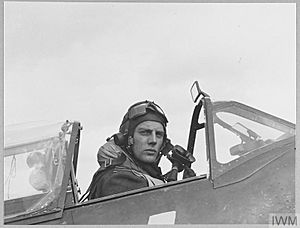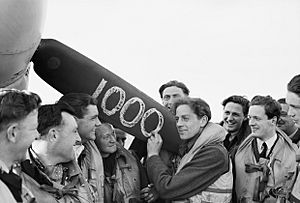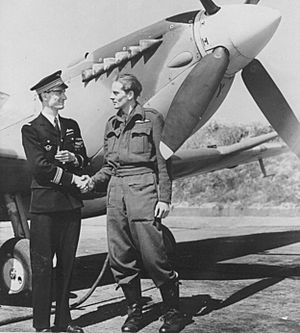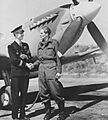Edward Charles (RAF officer) facts for kids
Quick facts for kids
Edward Francis John Charles
|
|
|---|---|

Charles seated in the cockpit of his Spitfire fighter, 1943
|
|
| Born | 6 February 1919 Coventry, England |
| Died | 5 November 1986 (aged 67) Vancouver, Canada |
| Allegiance | Canada |
| Service/ |
Royal Canadian Air Force Royal Air Force |
| Years of service | 1938–1939 (RCAF) 1939–1944 (RAF) 1944–1951 (RCAF) |
| Rank | Wing Commander |
| Commands held | RAF Tangmere Portreath Wing Middle Wallop Wing No. 611 Squadron |
| Battles/wars | Second World War |
| Awards | Distinguished Service Order Distinguished Flying Cross and Bar Silver Star (United States) |
Edward Francis John Charles (6 February 1919 – 5 November 1986) was a brave Canadian pilot who became a flying ace during the Second World War. He was born in England but grew up in Canada. He flew for both the Royal Canadian Air Force (RCAF) and the Royal Air Force (RAF). During his time as a pilot, he shot down at least fifteen enemy aircraft.
Edward Charles was born in Coventry, England. When he was a child, his family moved to Saskatchewan, Canada. In 1938, he joined the RCAF. The next year, he joined the RAF. After finishing his flight training, he joined No. 81 Squadron. In August 1940, he joined Fighter Command. He was sent to No. 54 Squadron, where he flew the famous Supermarine Spitfire fighter plane.
He flew during the later part of the Battle of Britain. The next year, he took part in the Circus offensive. During these missions, he shot down several enemy planes. In July 1941, he received the Distinguished Flying Cross (DFC) for his bravery. For the rest of 1941 and most of 1942, he worked as a flight instructor.
Charles returned to active flying in early 1943. Soon after, he became the commander of No. 611 Squadron. Later that year, he led groups of fighter planes from Middle Wallop and then Portreath. During this time, he was awarded the Distinguished Service Order. He had already received a bar to his DFC earlier that year, which meant he earned the DFC a second time. He later worked in a staff role and then transferred back to the RCAF. He continued to serve in the RCAF after the war. He passed away in 1986 in Vancouver, Canada.
Contents
Early Life and Joining the Air Force
Edward Francis John Charles was born in Coventry, England, on 6 February 1919. His father was a pilot in the Royal Flying Corps. When Edward was a child, his family moved to Canada. They settled in Lashburn, Saskatchewan. He went to Lashburn High School.
In June 1937, Charles joined the local militia. In January 1938, he joined the Royal Canadian Air Force (RCAF). The next year, he went to the United Kingdom. On 15 May 1939, he officially joined the Royal Air Force (RAF) as a pilot officer. He completed his flight training at several schools. In September 1939, he went to the School of Army Co-Operation.
World War II Service
In December 1939, Charles joined No. 81 Squadron. He served with this unit until June 1940. He then moved to No. 2 Squadron. This squadron used Westland Lysander planes to help ground troops. After only a few weeks, he volunteered to join Fighter Command.
In August, he went to a special training unit. The next month, he joined No. 54 Squadron. By this time, he was a flying officer. His squadron flew Supermarine Spitfire fighter planes. They had been very busy fighting in the Battle of Britain. Now, they were based at Catterick. They would sometimes fly to stop enemy bombers, but it was mostly quiet.
Fighting in the Circus Offensive
In February 1941, No. 54 Squadron moved to Hornchurch. They started taking part in the "circus offensive." These were missions where British fighters would fly into France. Their goal was to make German fighters come out and fight. They also escorted bombers.
On 17 April, Charles shot down a Messerschmitt Bf 110 heavy fighter. This was his first confirmed aerial victory. On 17 June, he probably destroyed a Messerschmitt Bf 109 fighter near Cap Gris-Nez. This started a successful period for him. On 21 June, he destroyed a Bf 109 over the English Channel. Three days later, he probably destroyed another over the Pas-de-Calais area.
On 27 June, he shot down a Bf 109 over Lille. On 30 June, he probably destroyed another Bf 109. He claimed another probable Bf 109 on 4 July. On the same mission, over Béthune, he definitely destroyed a second Bf 109. On 8 July, he helped destroy a Bf 109 near Lille. The next day, he shot down a Bf 109 near Saint-Omer.
Because of his successes, he received the Distinguished Flying Cross (DFC). The award was announced on 15 July. The official statement said he showed "exceptional zeal" and "immense enthusiasm." It also said he had destroyed at least three enemy aircraft.
On 20 July, Charles, flying a Spitfire Mk Vb, shot down a Bf 109 over Le Touquet. He claimed two more Bf 109s as probably destroyed on 23 July and 17 September. By this time, he was a flight lieutenant. His last victory with No. 54 Squadron was on 27 September. He helped destroy a Bf 109 off Mardyck. After this, he went to a training school to become an instructor. He spent most of 1942 teaching other pilots.
Leading Squadrons at Biggin Hill
In January 1943, Charles returned to flying missions. He joined No. 64 Squadron. This Spitfire squadron was part of the Hornchurch fighter wing. Their job was to fly sweeps and escort bombers over occupied Europe. After almost three months, he damaged a Focke Wulf 190 near Dunkirk.
He then moved to No. 611 Squadron as a flight commander. His new squadron flew Spitfire Mk IX planes. They were based at Biggin Hill. On 18 April, he made his first claim with this unit. He destroyed a Fw 190 over the Bay d'Authie. A few days later, he became the commander of the squadron.
On 4 May, he damaged a Fw 190. Three days later, he damaged a Bf 109. On 14 May, he shot down a Fw 190. The next day, he destroyed two Fw 190s southeast of Caen. The second of these might have been the 1,000th enemy aircraft shot down by a squadron from Biggin Hill. Commandant René Mouchotte, another squadron commander, also shot down a Fw 190 around the same time. They shared a prize for claiming the 1,000th aircraft. Two days later, Charles shot down another Fw 190 near Cabourg. He destroyed another Fw 190 on 23 June. On 5 July, he damaged a second one.
His successes led to him receiving a Bar to his DFC on 16 July. This meant he earned the DFC a second time. The official statement said he was a "first class fighter." It praised his "fine leadership, cool judgement and efficiency." It also stated he had destroyed 13 enemy aircraft and damaged several more.
Just five days later, Charles received the Silver Star. This was a bravery medal from the United States. It recognized his squadron's efforts in escorting American bombers on raids to France. On the same day, Charles shot down a Fw 190 and damaged a Bf 109 over Amsterdam. Later that month, the squadron moved north to get new Spitfire Mk LF. Vb planes.
In August, Charles was promoted to wing commander. He became the leader of the fighter wing at Middle Wallop. There, he destroyed a Fw 190 near Île de Batz. The next month, he became commander of the fighter wing at Portreath. On one mission, he shot down a Bf 110 west of Brest.
He stopped flying combat missions at the end of the month. He was sent to the headquarters of No. 10 Group, Fighter Command. At the end of October, Charles was awarded the Distinguished Service Order. This award recognized his leadership and skill. The official statement said he was an "inspiring leader" and had destroyed at least 15 enemy aircraft.
Later War Service
At the start of 1944, Charles returned to Canada for a lecture tour. He came back to Europe in April. The next month, his time with the RAF ended. He transferred back to the RCAF. He worked in a staff role at the Allied Expeditionary Air Forces. Later, he became the commander of Tangmere Station. By the end of the war, he was credited with shooting down fifteen German aircraft. He also shared in the destruction of one more. He probably destroyed six enemy planes and shared in one probable. He also damaged five aircraft.
Life After the War
After the war, Edward Charles returned to Canada. He continued to serve in the RCAF. However, after a few years, he started to experience mental health issues. In 1949, he was diagnosed with schizophrenia. The stress of his service during the Second World War might have played a part in this.
Although he received successful treatment, the condition returned. In 1951, he was discharged from the RCAF due to his health. He was admitted to Shaughnessy Veterans' Hospital in Vancouver. He remained there for the rest of his life, receiving care. He passed away at the hospital on 6 November 1986, at the age of 67.
Images for kids






